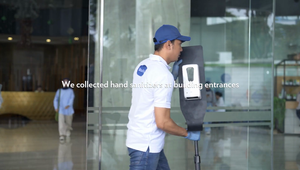
Debbie Ellison’s Guide to Shopstreaming

Live commerce – or ‘shopstreaming’ as the team at VMLY&R Commerce call it – is a trend that’s been huge in China since 2016, but in other parts of the world has been growing in a more piecemeal way, as platforms figure out their offerings and brands figure out how to bring operations, experience, content and commerce together.
As an agency that’s immersed in all things commerce, this is a space that VMLY&R Commerce has been working in for some time. Businesses like IKEA and beauty brand essence have sought their expertise to bring that warm, human connection to their online shopping experiences.
Debbie Ellison takes us up to speed with shopstreaming in 2022 and shares tips, tools and brands that are getting it right.
LBB> What are your tips for brands seeking to dip their toes into live commerce?
1. Start by really understanding your shoppers and what makes them tick
Your shoppers won’t be a homogenous group of people. Get to know your cohorts, their cultural influences, the moments that matter to them and how your brand and products play a role in their lives. Feature products and bundles that are limited editions or exclusives to build the hype – think of live commerce as a completely new creative commerce channel that needs differentiation in the eyes of your audience and then ensure you use paid media to target the right people. Kiel’s, the skincare brand, leveraged Live Commerce for its Ramadan campaign with a creative execution that appealed to both Ramadan observers and non-observers. The centre point of the campaign was a series of “open house” Instagram Live events featuring Kiehl’s beauty advisors – a strategy that delivered an 8-fold return on investment.
2. Connect your cohorts to the right influencers and then Test, Test, Test
There are no guaranteed formulas of what works and what doesn’t when it comes to
audiences, especially younger audiences like Gen Z. Consider engaging micro-influencers that can be matched to the specific interests of the cohorts you’re targeting.
If you’ve done any live streaming before, review the data and extract any insights you can. (e.g., what talent has worked best in the live format? Which topics of conversation gained the most interaction? Days and times in the week that worked best in terms of engagement? Drop off points that might hint to where audiences lost interest?) Once those insights are available, begin by adopting a test and learn approach using an off-the-shelf tool and a key moment that’s relevant to your audience where your brand has some clear authority and authenticity. Building a fully customised technology can get costly, especially when considering desktop, iOS and android compatibility (apparently $180-300K). Tools like Lisa and Bambuser provide seamless integration across e-com, apps and social that will allow you to track sales, conversion rates and engagements across multiple platforms.
LBB> What’s driving the interest in live commerce? Is this another youth-driven trend or is it something with a broader potential market?
Debbie>
1. Trust, authenticity, and relatability
Live Shopping or ‘Shopstreaming’ as we prefer to refer to it as, is the antithesis of overly produced and airbrushed creative, carefully crafted eCommerce shots, and size-zero models. Users can see products in real-time to make more educated decisions in a relatable context. When Live Shopping is curated by micro-influencers or creators who can tap into the minds of communities on an attitudinal level, users can experience product and inventory authentically.
2. A new way for audiences to interact with their favourite celebs, influencers and brands
The experience feels more exclusive, intimate, and spontaneous. It creates real time feedback where viewers have the chance to get their comments acknowledged and can influence what the broadcaster says or does. When applied to live commerce, products can feel more exclusive, and the exposure to other shoppers interacting in the feed can increase the hype. We do see a skew to youth because Gen Z are more active and available on social, embrace new features and trends more readily, and have a higher propensity to use social for shopping. However, like many Gen Z-driven trends, we’ll see live shopping becoming much more mainstream as creative commerce experiences are embraced by a wider range of brands and influencers. Viya, the live, online shopping influencer in China, created a winning formula of part-variety show, part-infomercial, part-group chat, connected to a payment portal. Viya and Li Jia Qi, another leading live streamer, sold a reported $400 million worth of goods in just one day on Taobao.
LBB> What platforms are having the most success or traction?
Debbie> According to an Insider Intelligence report, from 2019 to 2020 the number of US social e-commerce shoppers grew 25% to 80m, a number which is forecast to grow to more than 100m by 2023. Instagram and Tik Tok are leading the way. #TikTokMadeMeBuyIt, where users post what they've bought thanks to recommendations about products on the site, has been used 8.1bn times to date.
We’ve got to look to China for the biggest successes as that’s where Live Commerce is most mature. In a 2020 survey, two-thirds of Chinese consumers said they had bought products via livestream in the past year. The value of China’s live-commerce market grew at a compound annual growth rate (CAGR) of more than 280 percent between 2017 and 2020, to reach an estimated $171 billion in 2020.This growth spurt has been intensified by the Covid-19 pandemic, and Chinese sales are expected to reach $423 billion by 2022. Alibaba’s Taobao is China’s biggest live-commerce platform. Li Jiaqi is the top livestream salesman - known as the “lipstick brother”, he sold $1.9 billion in goods on the first day of Alibaba’s annual shopping festival.
LBB> What should a brand or agency take into consideration when figuring out what sort of platform to partner with?
Debbie>
1. Connect the product catalogue correctly
Ensure your inventory volume is accurate to minimise friction and maintain a seamless user experience. This will also improve discoverability of related inventory. Finding the platform where your core audience spends time most will also help prioritise effort.
2. Consider the entire path to purchase
Stitch together platforms that make the journey frictionless even if users click out or land on different properties. Test the complete customer experience (CX) from the perspective of all your audiences and make sure there are no dead ends or barriers to purchase.
LBB> How does this differ from old school TV shopping channels, and is there anything we can learn from the likes of QVC?
Debbie> Live shopping, particularly within the social space, democratises the experience - shoppers can interact and comment, providing live feedback, and brands often utilise influencers and creators to showcase products in realistic settings. In contrast, traditional TV shopping channels were hosted by professionals and celebrities in sterile studios with glitzy lights and camera tricks.
What we can learn from TV shopping channels like QVC is that the presenters are experts at helping the audience visualise how a product can fit into their lives, making products feel both useful and essential. They also leverage classic behavioural economic tactics like creating a sense of urgency by letting viewers know there is a limited supply and demand is high. These types of tactics can and should be applied directly to social commerce.
LBB> What brands are you seeing achieve particular success with this?
Debbie> Charlotte Tilbury hosts on average three live sessions per week on various topics (e.g., SPA skin, flawless coverage, etc.) and often along with industry icons like Kate Moss where 30-minute skincare and makeup tutorials are centred around product categories or bundles to achieve a look or effect. The products featured in these tutorials can be added to basket directly from the live stream.
In China 35.6% of live-commerce streamers are apparel and fashion, compared to only 7.6% beauty. On the fashion front, Tommy Hilfiger was one of the first brands to get into live commerce with Amazon and has recently extended its livestream program to Europe and North America following successes in China, where one show reportedly attracted an audience of 14 million and sold 1,300 hoodies in two minutes
LBB> Can you talk us through any examples that you have worked on - why was live commerce the ideal solution, what was unique or interesting about the project and what did you learn from it?
Debbie> To steer young beauty addicts to the essence online shop and increase sales, a host of conversion-optimised live shopping events was organised in 2020. The technology offered an immersive shopping experience and enabled essence to use participant data for retargeting purposes. With several thousand viewers, an average chat engagement of 63% and an average session time of 14 minutes; live shopping events proved to be an effective way of driving brand and product engagement as well as sales.
Working with Ikea in Poland, we drove engagement and sales through special 20% off promotions offered only during live streaming sessions aired twice a week. Products presented in the live streams were linked to the online store through links to products being automatically added to the live stream comments section. Questions that were asked by viewers were displayed to the presenters and answered in real time on-air. The exclusivity of the promotions during the live streams were key to driving significant volumes of online sales.

LBB> In practical terms how are you bringing production and commerce teams together?
Debbie> There are many teams that need to come together to deliver success in live commerce. Some teams who are critical are a strategic team, to help understand where the commercial opportunities are for the products and through which types of consumers; a commerce CX team will ensure that for each audience, their journey from the stream to the purchase is as seamless and frictionless as possible; and a creative production team who truly understand the target audiences and how they like to be communicated to.
LBB> Does this form of production benefit from live or broadcast experience?
Debbie> Absolutely. It helps land the authenticity of content, allowing influencers to co-produce content and direct the overall look/feel and even script. Beta test with micro-communities to understand how the stream is influencing the audience targeted
LBB> Live commerce takes content creation right into the heart of the business, bringing it together with commerce and UX teams as well as logistics and supply chain - to what extent does this benefit from a bit of in-housing on the brand’s side? How can external partners, like agencies, best work so deep within the client?
Debbie> An agency’s value is that they have experience across a wide variety of brands and product categories. This experience is valuable when wanting to create stand-out and differentiation within existing and new audiences, especially in such a new channel. It is often very difficult to pull together the wide spectrum of experts needed to make live shopping successful, from commercial planning, creative, influencer identification and engagement right through to CX, UX, platform and technology. When connected and executed well, a live shopping experience will not only deliver sales but build brand equity too.
LBB> And how do you keep the content fresh and relevant?
Debbie> Curation is key and testing several different use cases for activations is important. Shopping moments can vary from calendar events to community championing or even aesthetic tribes. Understanding your audience attitudes through data and insight is key in devising curated Live Shopping experiences that cater to their interests.
Use a range of hosts who are experts or authorities in different areas. This will mix up the vibe and energy of the stream and help you appeal to different communities. You can also bring in multiple hosts so they can bounce off each other.
Encourage live feedback and review post live streams for key insights, trends and themes to refine and optimise creative, influencers and content.
LBB> What sort of content schedules seem to be most effective? Is it important to ‘own’ a regular live time? Should brands commit to prolonged streaming windows? Or can it be more effective to wait for big one-off events?
Debbie> For live shopping within a social platform, a regular cadence can help the algorithm ‘learn’ and improve organic discoverability.
Tying in with big events can certainly help focus efforts and generate hype. But do be mindful of events like Black Friday and Double 11, where media becomes expensive, and many brands compete for attention at the same time. To capitalise on an event like this, you need significant media budgets and considerable advertising support. However, if done right, livestreaming can be a great way of getting PR and cut through during seasonal events. For example, Burberry used Twitch to stream their 2021 spring/summer show for London Fashion Week, achieving a platform-first and tapping into a younger audience of gamers.
LBB> Where do you think that live commerce will go next?
Debbie> Social platforms will continue to invest in feature development and promotion of live commerce. We’ll see more brands trying to enter the space, investing in collaborations and influencer partnerships to do so and some brands like Nordstrom will establish permanent live shopping channels. Live commerce will be matched with evolving behaviours, led by Gen Z, that will see mainstream adoption of live commerce. Given the number of influencers creating their own content, reviewing products in real time, I’d also like to see platforms provide comprehensive functionality for creators to link their content to commerce opportunities to help them connect their followers to purchase directly.















